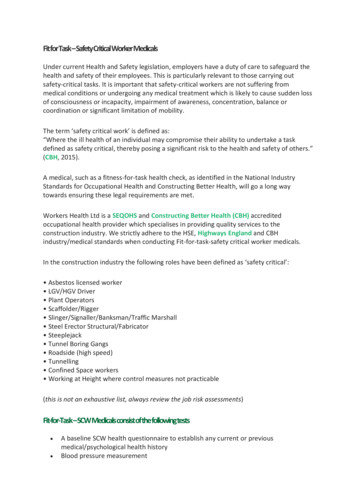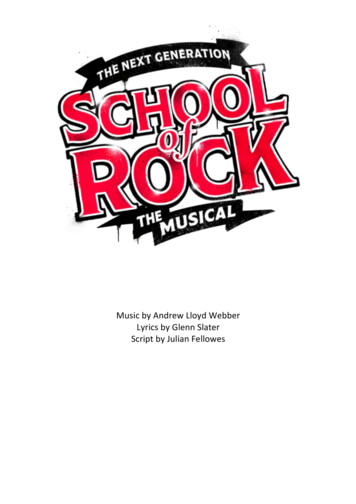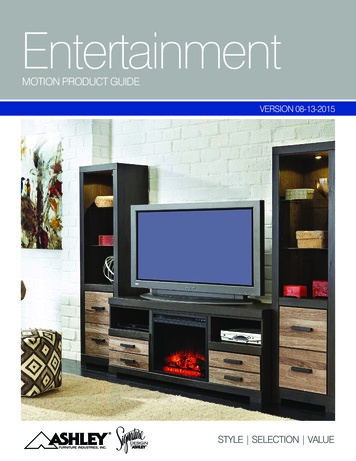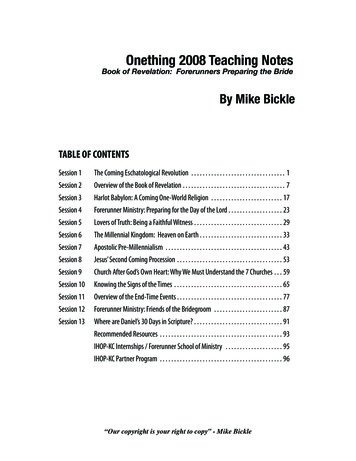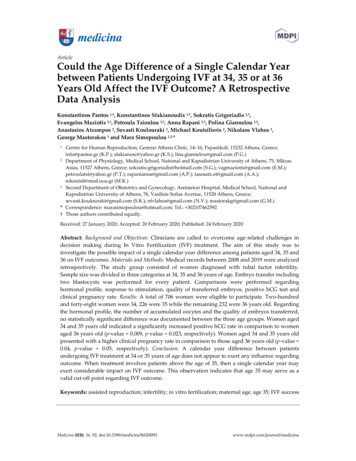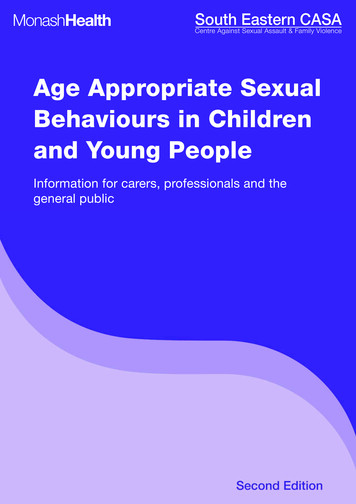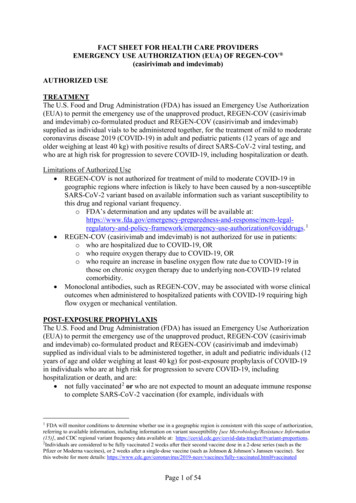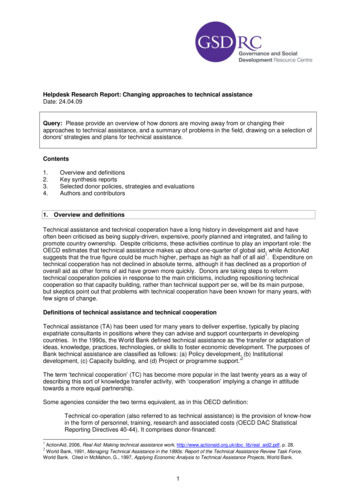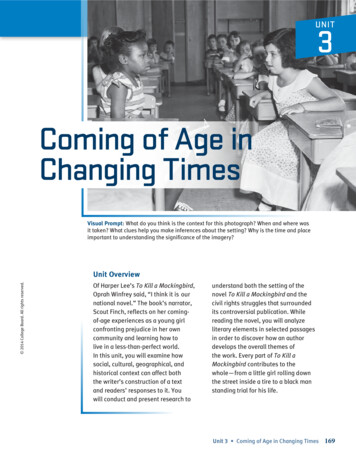
Transcription
UNIT3Coming of Age inChanging TimesVisual Prompt: What do you think is the context for this photograph? When and where wasit taken? What clues help you make inferences about the setting? Why is the time and placeimportant to understanding the significance of the imagery? 2014 College Board. All rights reserved.Unit OverviewOf Harper Lee’s To Kill a Mockingbird,Oprah Winfrey said, “I think it is ournational novel.” The book’s narrator,Scout Finch, reflects on her comingof-age experiences as a young girlconfronting prejudice in her owncommunity and learning how tolive in a less-than-perfect world.In this unit, you will examine howsocial, cultural, geographical, andhistorical context can affect boththe writer’s construction of a textand readers’ responses to it. Youwill conduct and present research tounderstand both the setting of thenovel To Kill a Mockingbird and thecivil rights struggles that surroundedits controversial publication. Whilereading the novel, you will analyzeliterary elements in selected passagesin order to discover how an authordevelops the overall themes ofthe work. Every part of To Kill aMockingbird contributes to thewhole—from a little girl rolling downthe street inside a tire to a black manstanding trial for his life.Unit 3 Coming of Age in Changing Times169
Coming of Age in Changing Times3GoalS: To gather and integraterelevant information frommultiple sources to answerresearch questions To present findings clearly,concisely, and logically,making strategic use ofdigital mediaContentsActivities3.13.2 Picturing the Past. 173*Photographs: Southern life from the 1930s to the 1960s3.3 To analyze how literaryelements contribute to thedevelopment of a novel’sthemes To write a literary analysis,citing textual evidenceto support ideas andinferencesacademic vocabularycontextprimary sourcesecondary sourceplagiarizeparenthetical citationsvalidrhetoricbibliographyannotated bibliographyevaluatecensorcensorshipLiterary Termsexpository writingflashbackmotifplotsubplotsymbolflat/static characterround/dynamic characterPreviewing the Unit. 172Setting the Context. 176 Informational Text: “Jim Crow: Shorthand for Separation,”by Rick Edmonds Informational Text: Jim Crow Laws, Martin Luther King, Jr.National Historic Site, compiled by the National Park Service3.4 Researching and Presenting Information . 183*Website: “The Rise and Fall of Jim Crow,” PBS3.5 A Time for Change. 186 Letter: from “Letter from Birmingham Jail,”by Martin Luther King, Jr.3.6Voices of Change. 1923.7Historical Research and Citation. 1943.8Reaching an Audience. 199Embedded Assessment 1: Historical Investigation andPresentation. 2013.9 Previewing Embedded Assessment 2:A Story of the Times . 203 Reflective Texts: Excerpt from Scout, Atticus and Boo: ACelebration of To Kill a Mockingbird by Mary McDonagh Murphy3.10 A Scouting Party. 207Novel: Excerpt from To Kill a Mockingbird, by Harper Lee *Film: Clips from To Kill a Mockingbird, directedby Robert Mulligan3.11Conflict with Miss Caroline. 2113.12 Analyzing Boo. 213Novel: Excerpt from To Kill a Mockingbird, by Harper Lee3.13Questions and Conclusions. 2193.14 Two Views of “One Shot”. 222Novel: Excerpt from To Kill a Mockingbird, by Harper Lee *Film: Clip from To Kill a Mockingbird, directedby Robert Mulligan170SpringBoard English Language Arts Grade 9 2014 College Board. All rights reserved.UNIT
3.15 Pin the Quote on Atticus . 224Novel: Excerpt from To Kill a Mockingbird, by Harper Lee3.16 Shifting Perspectives. 2283.17 A Solitary Light. 230 *Film: Clip from To Kill a Mockingbird, directedby Robert Mulligan3.18Language and Writer’sCraft Citing Sources (3.4) IncorporatingQuotations (3.15) Three-foldTransitions (3.20)Characters’ Voices. 2323.19 Analyzing Atticus’s Closing Argument. 233Novel: Excerpt from To Kill a Mockingbird, by Harper Lee *Film: Clip from To Kill a Mockingbird, directedby Robert Mulligan3.20Aftermath and Reflection. 2383.21 Standing in Borrowed Shoes. 2413.22 Controversy in Context. 243 Essay: Excerpt from “In Defense of To Kill a Mockingbird,”Nicholas J. Karolides, et al.3.23“Hey, Boo”. 247Embedded Assessment 2:Writing a Literary Analysis Essay . 249 2014 College Board. All rights reserved.*Texts not included in these materialsUnit 3 Coming of Age in Changing Times171
ACTIVITY3.1Previewing the UnitLearning Strategies:Close Reading, Marking theText, Skimming/Scanning,Summarizing, Graphic OrganizerLearning Targets Explore preliminary thinking by writing responses to the Essential Questions. Identify the skills and knowledge required to complete Embedded Assessment 1successfully.Making ConnectionsMy NotesIn this unit, you will study the novel To Kill a Mockingbird in depth. As part ofthis study, you will examine the historical and cultural context of the novel andanalyze literary elements that develop the themes of the novel. You will also applyyour knowledge of film techniques as you examine clips from the film To Kill aMockingbird, analyze the director’s choices, and make comparisons between filmand literary elements in the novel.Essential QuestionsBased on your current knowledge, write your answers to these questions:1. What impact does context have on a novel and on the reactions of readers to it?2. How does a key scene from a novel contribute to the work as a whole?Review the terms listed on the Contents page for Academic Vocabulary and LiteraryTerms. Use a QHT or other strategy to analyze and evaluate your knowledge ofthose words. Use your Reader/Writer Notebook to make notes about meaningsyou know already. Add to your notes as you study this unit and gain greaterunderstanding of each of these words.Unpacking Embedded Assessment 1IndependentReading LinkFor independent reading inthis unit, you might chooseanother novel or you mightread informational textsabout the United Statesduring the 1930s—the timeperiod in which To Kill aMockingbird is set.172Read the assignment for Embedded Assessment 1: Historical Investigation andPresentation.Your assignment is to research the historical, cultural, social, and/orgeographical context of the novel To Kill a Mockingbird and investigate howindividuals, organizations, and events contributed to change in the UnitedStates during the Civil Rights Movement. You will work collaboratively to createan oral presentation of your findings with multimedia support and guidingquestions for your audience.In your own words, summarize what you will need to know to complete thisassessment successfully. With your class, create a graphic organizer to representthe skills and knowledge you will need to complete the tasks identified in theEmbedded Assessment.SpringBoard English Language Arts Grade 9 2014 College Board. All rights reserved.Developing Vocabulary
Picturing the PastACTIVITY3.2Learning Targets Identify the historical, cultural, social, and geographical contexts of the setting,writing, and publication of the novel To Kill a Mockingbird. Summarize observations about context from visual images.Learning Strategies:Graphic Organizer, WordMaps, Drafting, DiscussionGroupsDeveloping Context1. With a partner, brainstorm what you already know about the idea of context.Create a web graphic organizer below.Once you have investigated the idea of context, add branches for historical,cultural, social, and geographical aspects. In your discussion, be sure youunderstand what each term describes in relation to context.Contextacademic vocabularyWhen reading a text, youmay find words that you donot know. You can use thecontext—the words aroundthe text—to infer meaning.In the same way, the contextof a novel or a situationrefers to the circumstancesor conditions in which thething exists or takes place.Knowing context helps youunderstand the novel orsituation better. 2014 College Board. All rights reserved.My Notes2. To develop an understanding of the context for the novel To Kill a Mockingbird,view the photographs your teacher has provided. Keep in mind that the novel isset in the 1930s, but it was written years later and first published in 1960. Note your observations and questions about the images on the graphicorganizer on the next page.Unit 3 Coming of Age in Changing Times173
ACTIVITY 3.2Picturing the PastcontinuedPhoto #Observation (Note thedetails of the image in thephotograph.)Reflection (What is yourresponse to the images in thephotograph?)Questions (What questionscome to mind that mightlead to further exploration orresearch?) 2014 College Board. All rights reserved.UnitOpenerphoto174SpringBoard English Language Arts Grade 9
ACTIVITY 3.2continued3. Discussion Groups: After viewing the photographs, meet with your group todiscuss the questions you have created. You may want to use these questionsto prompt your research for the Embedded Assessment. Share and respond toothers’ questions, and add new questions to your own list.Writing Prompt: Summarize what you learned from the photographs about thecontext of the setting, writing, and publication of the novel To Kill a Mockingbird.Be sure to do the following: Begin with a topic sentence summarizing your understanding of the contextprovided by the photographs. Include specific relevant details about images that stood out or informed yourunderstanding. Provide commentary about what you saw and learned.IndependentReading LinkAs you begin yourindependent reading, thinkabout the historical, cultural,and social contexts reflectedin the setting, for example,in the ways that charactersbehave. If you are readinga novel, consider the waysthat the contexts, togetherwith literary elements,contribute to the generaleffect of the novel andits theme. 2014 College Board. All rights reserved.My NotesUnit 3 Coming of Age in Changing Times175
ACTIVITY3.3Setting the ContextLearning Strategies:Marking the Text, MetacognitiveMarkers, PreviewingLearning Target Analyze a secondary and a primary source to understand the cultural, social,and legal contexts of the novel To Kill a Mockingbird.Before ReadingMy Notes1. Consider the following quotations by American presidents. What do they tellyou about the progress toward equal rights for all races during this period oftime in our country?“Every segment of our population, and every individual, has a right to expect from hisgovernment a fair deal.” —Harry S. Truman, 1945“The final battle against intolerance is to be fought—not in the chambers of anylegislature—but in the hearts of men.” —Dwight D. Eisenhower, 1956“There are no ‘white’ or ‘colored’ signs on the foxholes or graveyards of battle.”—John Fitzgerald Kennedy, 1963“The vote is the most powerful instrument ever devised by man for breaking downinjustice and destroying the terrible walls which imprison men because they aredifferent from other men.” —Lyndon B. Johnson, 19652. Focus Question: What were Jim Crow laws? As you read the following article,mark the text to identify the words and phrases that help you to define themeaning of the term Jim Crow and understand its importance in Americanhistory.176SpringBoard English Language Arts Grade 9 2014 College Board. All rights reserved.During Reading
ACTIVITY 3.3continuedInformational TextGRAMMAR USAGEJim Crow:Shorthand for Separationby Rick Edmonds“Jim Crow” the term, like Jim Crow the practice, settled in over a long period oftime. By the 1950s, Jim Crow was the colloquialism whites and blacks routinely usedfor the complex system of laws and customs separating the races in the South. Hardlyanyone felt a particular need to define it or explore its origins.The term appears to date back at least to the eighteenth century, though there isno evidence that it refers to an individual. Rather it was mildly derogatory slang for ablack everyman (Crow, as in black like a crow). A popular American minstrel song ofthe 1820s made sport of a stereotypic Jim Crows. “Jump Jim Crow” was a sort of jig.By the mid-1800s, a segregated rail car might be called the “Jim Crow.” As segregationlaws were put into place—first in Tinnessee, then throughout the South—afterReconstruction, such diverse things as separate public facilities and laws restrictingvoting rights became known collectively as Jim Crow. 2014 College Board. All rights reserved.A bit like “political correctness” in recent years, the term was particularly popularwith opponents of the practice. It was a staple of NAACP conversations of the ’30sand ’40s. Ralph Bunche once said he would turn down an appointment as ambassadorto Liberia because he “wouldn’t take a Jim Crow job.” A skit at Morehouse Collegeduring Martin Luther King’s student days portrayed a dramatic “burial” of Jim Crow.And . at the eventful Republican National Convention in 1964 in San Francisco,picketers outside the hall chanted, “Jim Crow (clap, clap) must go.” .Prepositional PhrasesThe second sentence inthis essay begins with aprepositional phrase, “Bythe 1950s.” A prepositionalphrase consists of apreposition, its object, andany modifiers of the object.Common prepositions includeabout, across, in, by, after,on, for, until, at, and up.A preposition shows therelationship or connectionbetween its object and someother word. In the sentenceidentified above, for example,by shows the relationshipbetween “1950s” and theterm “Jim Crow.”My NotesFrom material in American Heritage Dictionary, Safire’s Political Dictionary, and FromSlavery to Freedom.After Reading3. Work with your class to create a working definition of Jim Crow laws, and writethe definition below.Unit 3 Coming of Age in Changing Times177
ACTIVITY 3.3Setting the ContextcontinuedMy NotesBefore Reading4. Scan the Jim Crow laws on the next few pages. Using the bold type as a guide,work with other members of your group to create a list of possible categoriesinto which you might sort the laws.During Reading5. Focus Question: How did Jim Crow laws deprive American citizens of their rights? Asyou read, use metacognitive markers to respond to the text as follows: Put a ? next to lines that are confusing or bring up questions. Put a * next to lines that are interesting or reinforce what you already know. Put a ! next to lines that are surprising or help you make predictions.Informational TextJim Crow LawsMartin Luther King Jr. National Historic SiteCompiled by the National Park Service, US Department of the InteriorWhat is the significance of thereferences to gender as wellas race in some of these laws?1 Nurses No person or corporation shall require any white female nurse to nursein wards or rooms in hospitals, either public or private, in which negro men areplaced. Alabama2 Buses All passenger stations in this state operated by any motor transportationcompany shall have separate waiting rooms or space and separate ticket windows forthe white and colored races. Alabama3 Restaurants It shall be unlawful to conduct a restaurant or other place for theserving of food in the city, at which white and colored people are served in the sameroom, unless such white and colored persons are effectually separated by a solidpartition extending from the floor upward to a distance of seven feet or higher, andunless a separate entrance from the street is provided for each compartment. Alabama4 Pool and Billiard Rooms It shall be unlawful for a negro and white person to playtogether or in company with each other at any game of pool or billiards. Alabama5 Intermarriage The marriage of a person of Caucasian blood with a Negro,Mongolian, Malay, or Hindu shall be null and void. Arizona178SpringBoard English Language Arts Grade 9 2014 College Board. All rights reserved.Key Ideas and Details
ACTIVITY 3.3continued6 Intermarriage All marriages between a white person and a negro, or betweena white person and a person of negro descent to the fourth generation inclusive, arehereby forever prohibited. Florida7 Education The schools for white children and the schools for negro children shallbe conducted separately. Florida8 Mental Hospitals The Board of Control shall see that proper and distinctapartments are arranged for said patients, so that in no case shall Negroes and whitepersons be together. Georgia9 Barbers No colored barber shall serve as a barber [to] white women or girls.Georgia10 Burial The officer in charge shall not bury, or allow to be buried, any coloredpersons upon ground set apart or used for the burial of white persons. Georgia11 Restaurants All persons licensed to conduct a restaurant shall serve either whitepeople exclusively or colored people exclusively and shall not sell to the two raceswithin the same room or serve the two races anywhere under the same license. Georgia12 Amateur Baseball It shall be unlawful for any amateur white baseball team toplay baseball on any vacant lot or baseball diamond within two blocks of a playgrounddevoted to the Negro race, and it shall be unlawful for any amateur colored baseballteam to play baseball in any vacant lot or baseball diamond within two blocks of anyplayground devoted to the white race. GeorgiaWordConnectionsForeign WordsLegal documents use manyforeign words and phrases,primarily Latin. Quid pro quomeans “to give something ofvalue to get something elseof value in return.” Ipso factomeans “by the fact itself.”It may be used to describefactual evidence.Key ideas and detailsWhy is the Jim Crow lawabout care of the blindparticularly ironic?My Notes13 Parks It shall be unlawful for colored people to frequent any park ownedor maintained by the city for the benefit, use and enjoyment of whitepersons . and unlawful for any white person to frequent any park owned or maintainedby the city for the use and benefit of colored persons. Georgia 2014 College Board. All rights reserved.14 Reform Schools The children of white and colored races committed to the housesof reform shall be kept entirely separate from each other. Kentucky15 Circus Tickets All circuses, shows, and tent exhibitions, to which the attendanceof . more than one race is invited or expected to attend shall provide for theconvenience of its patrons not less than two ticket offices with individual ticket sellers,and not less than two entrances to the said performance, with individual ticket takersand receivers, and in the case of outside or tent performances, the said ticket offices shallnot be less than twenty-five (25) feet apart. Louisiana16 The Blind The board of trustees shall . maintain a separate building . on separateground for the admission, care, instruction, and support of all blind persons of thecolored or black race. Louisiana17 Railroads All railroad companies and corporations, and all persons runningor operating cars or coaches by steam on any railroad line or track in the State ofMaryland, for the transportation of passengers, are hereby required to provide separatecars or coaches for the travel and transportation of the white and colored passengers.MarylandUnit 3 Coming of Age in Changing Times179
ACTIVITY 3.3Setting the ContextcontinuedAs used here, the wordpromotion means the actof furthering the growth ordevelopment of something. Apromotion might also mean ajob promotion to a higher-levelposition.Key Ideas and DetailsHow might the law abouthospital entrances bedangerous to people whocould not use the mainentrance?WordConnectionsRoots and AffixesThe word transportationmeans “a method of movingpassengers or goods from oneplace to another.” The Latinprefix trans- means “across” or“beyond.” The Latin root portmeans “to carry” or “to bear.”The root port is found in manyother English words, such asportable, portfolio, import,export, report, and support.Some of the words in whichthe prefix trans- appears aretransfer, transform, transition,translate, and transparent.My Notes18018 Promotion of Equality Any person . who shall be guilty of printing, publishingor circulating printed, typewritten or written matter urging or presenting for publicacceptance or general information, arguments or suggestions in favor of social equalityor of intermarriage between whites and negroes, shall be guilty of a misdemeanorand subject to fine not exceeding five hundred (500.00) dollars or imprisonment notexceeding six (6) months or both. Mississippi19 Intermarriage The marriage of a white person with a negro or mulatto or personwho shall have one-eighth or more of negro blood, shall be unlawful and void.Mississippi20 Hospital Entrances There shall be maintained by the governing authorities ofevery hospital maintained by the state for treatment of white and colored patientsseparate entrances for white and colored patients and visitors, and such entrances shallbe used by the race only for which they are prepared. Mississippi21 Prisons The warden shall see that the white convicts shall have separate apartmentsfor both eating and sleeping from the negro convicts. Mississippi22 Education Separate free schools shall be established for the education of childrenof African descent; and it shall be unlawful for any colored child to attend any whiteschool, or any white child to attend a colored school. Missouri23 Intermarriage All marriages between . white persons and negroes or whitepersons and Mongolians . are prohibited and declared absolutely void. . No personhaving one-eighth part or more of negro blood shall be permitted to marry any whiteperson, nor shall any white person be permitted to marry any negro or person havingone-eighth part or more of negro blood. Missouri24 Education Separate rooms [shall] be provided for the teaching of pupils of Africandescent, and [when] said rooms are so provided, such pupils may not be admitted to theschool rooms occupied and used by pupils of Caucasian or other descent. New Mexico25 Textbooks Books shall not be interchangeable between the white and coloredschools, but shall continue to be used by the race first using them. North Carolina26 Libraries The state librarian is directed to fit up and maintain a separate place forthe use of the colored people who may come to the library for the purpose of readingbooks or periodicals. North Carolina27 Transportation The . Utilities Commission . is empowered and directed torequire the establishment of separate waiting rooms at all stations for the white andcolored races. North Carolina28 Teaching Any instructor who shall teach in any school, college or institutionwhere members of the white and colored race are received and enrolled as pupils forinstruction shall be deemed guilty of a misdemeanor, and upon conviction thereof,shall be fined in any sum not less than ten dollars ( 10.00) nor more than fifty dollars( 50.00) for each offense. OklahomaSpringBoard English Language Arts Grade 9 2014 College Board. All rights reserved.WordConnectionsMultiple Meanings
ACTIVITY 3.3continued29 Fishing, Boating, and Bathing The [Conservation] Commission shall have theright to make segregation of the white and colored races as to the exercise of rights offishing, boating and bathing. Oklahoma30 Telephone Booths The Corporation Commission is hereby vested with power andauthority to require telephone companies . to maintain separate booths for white andcolored patrons when there is a demand for such separate booths. That the CorporationCommission shall determine the necessity for said separate booths only upon complaintof the people in the town and vicinity to be served after due hearing as now provided bylaw in other complaints filed with the Corporation Commission. Oklahoma31 Lunch Counters No persons, firms, or corporations, who or which furnishmeals to passengers at station restaurants or station eating houses, in times limitedby common carriers of said passengers, shall furnish said meals to white and coloredpassengers in the same room, or at the same table, or at the same counter. SouthCarolina32 Libraries Any white person of such county may use the county free library underthe rules and regulations prescribed by the commissioners court and may be entitled toall the privileges thereof. Said court shall make proper provision for the negroes of saidcounty to be served through a separate branch or branches of the county free library,which shall be administered by [a] custodian of the negro race under the supervision ofthe county librarian. Texas33 Education [The County Board of Education] shall provide schools of two kinds;those for white children and those for colored children. Texas 2014 College Board. All rights reserved.34 Railroads The conductors or managers on all such railroads shall have power, andare hereby required, to assign to each white or colored passenger his or her respectivecar, coach or compartment. If the passenger fails to disclose his race, the conductor andmanagers, acting in good faith, shall be the sole judges of his race. VirginiaWordConnectionsMultiple Meaning WordsThe word provision has severalmeanings. It may mean tosupply or fit out, as in toprovision a campsite. As anoun, it may mean somethingprovided (or supplies in theplural). It may also mean astipulation or qualification,such as a clause in a documentor agreement. Use contextclues to determine themeaning of provision as it isused in paragraph 32.Key ideas and detailsWhat do the names of thestates tell you about thescope of Jim Crow laws?My Notes35 Theaters Every person . operating . any public hall, theatre, opera house,motion picture show or any place of public entertainment or public assemblage whichis attended by both white and colored persons, shall separate the white race and thecolored race and shall set apart and designate . certain seats therein to be occupied bywhite persons and a portion thereof, or certain seats therein, to be occupied by coloredpersons. Virginia36 Intermarriage All marriages of white persons with Negroes, Mulattos, Mongolians,or Malayans hereafter contracted in the State of Wyoming are and shall be illegal andvoid. WyomingUnit 3 Coming of Age in Changing Times181
ACTIVITY 3.3Setting the Contextcontinuedacademic vocabularyA primary source is an originaldocument containing firsthandinformation about a subject.A secondary source is adiscussion about or commentaryon a primary source; the keyfeature of a secondary source isthat it offers an interpretationof information gathered fromprimary sources.After Reading5. Revisit your list of categories of Jim Crow laws, revising it if needed. Work withyour group to create a poster that represents three to four categories andincludes brief summaries of several laws that fall into each category.6. Which of the sources in this activity is a primary source?7. What are the benefits of a primary source?WordConnectionsAnalogiesMy Notes8. Which is a secondary source?9. What are the benefits of a secondary source?10. Which source was more helpful to you in answering the research questionsabout Jim Crow laws, and why?182SpringBoard English Language Arts Grade 9 2014 College Board. All rights reserved.An analogy may use both wordsand phrases. For example,Jim Crow laws : segregationas negligence : accident.This analogy shows a causeeffect relationship. Writetwo additional cause-effectanalogies, either on your ownor as part of a class activity. Useboth phrases and words.
Researching and Presenting InformationLearning Targets Conduct research by exploring a website and gathering information for apresentation on the rise and fall of Jim Crow laws. Organize information into a coherent piece and make an oral presentation.ACTIVITY3.4Learning Strategies:KWHL, Note-taking, GraphicOrganizerOrganizing Information1. Based on the photographs and sources you examined in the previous activities,fill out the first two columns of the KWHL chart below. A KWHL chart is aneffective tool to help focus and refine research activity by determining whichtopics need further research and where to find the needed information.W: What more do I wantto know about Jim Crow?H: How will I findinformation?L: What have I learnedabout Jim Crow? 2014 College Board. All rights reserved.K: What do I knowabout Jim Crow?Unit 3 Coming of Age in Changing Times183
ACTIVITY 3.4Researching and Presenting Informationcontinuedacademic vocabularyPlagiarism is using anotherperson’s ideas without givingcredit. Researchers must alwaysgive credit by citing sources.Parenthetical citations are usedfor citing sources directly in anessay. In contrast, some writersplace citations in footnotes orendnotes.My Notes2. Choose at least three questions that you will use to guide your investigation ofthe PBS website “The Rise and Fall of Jim Crow”: www.pbs.org/
Jim Crow: Shorthand for Separation by Rick Edmonds “Jim Crow” the term, like Jim Crow the practice, settled in over a long period of time. By the 1950s, Jim Crow was the colloquialism whites and blacks routinely used for the complex system of l

